Study of Hybrid Transmission HVAC/HVDC by Particle Swarm Optimization (PSO)
Abstract
:1. Introduction
- The authors constructed models and simulations that changed several types of bus lines (HVAC) to buses (HVDC) in the SUMBAGUT 150 kV so that the transmission system became a hybrid. Some transmissions used the HVDC system, and some used the HVAC system using particle swarm optimization algorithms to get optimal locations. A comparative analysis between the simulation results of HVDC Transmission and Hybrid transmission (HVAC/HVDC) with PSO algorithms is a novel aspect of the current research.
- The authors use a monopolar metallic current return HVDC configuration in the transmission system.
- This study aims to determine which transmission methods can feasibly be replaced with HVDC transmission systems to produce a transmission system with the least possible losses.
- The power flow analysis method is analyzed in multiple bus systems using the Newton–Raphson method because it produces better calculations for large power systems.
2. Materials and Methods
2.1. Materials
2.2. Methods
- Determine the size of the swarm and determine the initial value of the position and velocity of the particle randomly.
- Evaluate the value of the objective function for each particle.
- Determine the first Gbest and Pbest.
- Calculate the speed in the next iteration with Equation (6).
- In these equations, the following variables are used: Iteration; 1,2,3,…n; random number; and acceleration coefficient.
- Determine the position of the particle in the next iteration using the following Equation (7).
- Evaluate the value of the objective function in the next iteration.
- Update the Pbest and Gbest
3. Results
3.1. Transmission System Power Flow SUMBAGUT 150 kV (HVAC)
3.2. Determination and Placement of HVDC Transmission Locations
3.3. Transmission HVDC of the Power Flow SUMBAGUT 150 kV
3.3.1. Paya Pasir (Bus 5)–Paya Geli (Bus 7)
3.3.2. Paya Pasir (Bus 5)–Sei Rotan (Bus 11)
3.3.3. Renun (Bus 66)–Sidikalang (Bus 63)
3.3.4. Paya Pasir (Bus 5)–Paya Geli (Bus 7) and Paya Pasir (Bus 5)–Sei Rotan (Bus 11)
3.3.5. Paya Pasir (Bus 5)–Paya Geli (Bus 7) and Renun (Bus 66)–Sidikalang (Bus 63)
3.3.6. Paya Pasir (Bus 5)–Sei Rotan (Bus 11) and Renun (Bus 66)–Sidikalang (Bus 63)
3.3.7. Paya Pasir (Bus 5)–Paya Geli (Bus 7), Paya Pasir (Bus 5)–Sei Rotan (Bus 11), and Renun (Bus 66)–Sidikalang (Bus 63)
4. Discussion
5. Conclusions
- The best line locations for conversion to hybrid HVAC/HVDC are the 150 kV Paya Pasir (Bus 5)–Paya Geli (Bus 7) transmission line (21 km), the 150 kV Paya Pasir (Bus 5)–Sei Rotan (Bus 11) transmission line (24 km), and the Renun (Bus 66)–Sidikalang (bus 63) transmission line (25 km), which were shown to have transmission losses of 5731 kW, 5179 kW, and 6080 kW, respectively. The network loss before HVAC was 68.41 MW. This shows that the transmission loss decreased after HVDC installation.
- The best combination of channels was the combination of these three transmission lines into a hybrid HVAC/HVDC. The 150 kV transmission conversion of Paya Pasir (Bus 5)–Paya Geli (Bus 7), Paya Pasir (Bus 5)–Sei Rotan (Bus 11), and Renun (Bus 66)–Sidikalang (Bus 63) gave the best channel conversion results with a total power loss of 38.71 MW for the entire SUMBAGUT transmission system, which represents a decrease of 43.41%. It was also shown that HVDC network losses experienced a very large decrease with the conversion of three transmission lines to HVDC compared with two transmission lines. Not only were network losses improved in the HVDC transmission system, but the voltage profile also improved.
- The HVDC transmission system is the most efficient transmission system for delivering power, not only in terms of its ability to overcome power losses based on the line length but also due to its ability to efficiently conduct power when the transmission end has a very large load.
- Particle swarm optimization was used to optimize the HVDC system, and the objective functions for the rectifier and inverter were evaluated individually. It was noted that the step change optimization solution had met the requirements for the stability and dynamic performance of the HVDC system.
Author Contributions
Funding
Data Availability Statement
Acknowledgments
Conflicts of Interest
References
- Quan, N.; Surya, S. Optimal Planning and Operation of Multi-Frequency HVAC Transmission Systems. IEEE Trans. Power Syst. 2021, 36, 689–698. [Google Scholar] [CrossRef]
- Ashoke, K.B.; Sina, I.A.; Shravan, K.A.; Hossein, S. High Voltage AC (HVAC) and High Voltage DC (HVDC) Transmission Topologies of Offshore Wind Power and Reliability Analysis. In Proceedings of the IEEE Green Technologies Conference (GreenTech), Denver, CO, USA, 7–9 April 2021. [Google Scholar]
- Ognjen, S.; Jared, G.; Sören, H.; Christian, M.F.; Turhan, D. Benefit Analysis of a Hybrid HVAC/HVDC Transmission Line: A Swiss Case Study. In Proceedings of the IEEE Milan PowerTech, Milan, Italy, 23–27 June 2019. [Google Scholar]
- Amit, K.; Subhasis, J.; Rajesh, S. HVDC Converter Stations Design for LCC Based HVDC Transmission System-Key Consideration. In Proceedings of the 14th IEEE India Council International Conference (INDICON), Roorkee, India, 15–17 December 2017. [Google Scholar] [CrossRef]
- Paul, M.A.; Charles, H.; Rasheek, R.; Brian, J.; Sakis, M. Line Commutated Converter HVDC Protection. In Power System Protection, 2nd ed.; Wiley-IEEE Press: Hoboken, NJ, USA, 2022; pp. 973–1019. [Google Scholar] [CrossRef]
- Oluwafemi, E.O.; Innocent, E.D.; Kamati, N.I.M. A review of LCC-HVDC and VSC-HVDC technologies and applications. In Proceedings of the IEEE 16th International Conference on Environment and Electrical Engineering (EEEIC), Florence, Italy, 7–10 June 2016. [Google Scholar] [CrossRef]
- Nsofwa, M.K.; Chitra, V.; Innocent, E.D. A review of the performance of VSC-HVDC and MTDC systems. In Proceedings of the IEEE PES Power Africa, Accra, Ghana, 27–30 June 2017. [Google Scholar]
- Sungchul, H.; Sungyoon, S.; Gilsoo, J.; Minhan, Y. An Operation Strategy of the Hybrid Multi-Terminal HVDC for Contingency. Energies 2019, 12, 2042. [Google Scholar] [CrossRef] [Green Version]
- Abdulate, A.M.E. The Corona Effect on High Voltage Transmission Lines. IJSETR Int. J. Sci. Eng. Technol. Res. 2019, 8, 29–31. [Google Scholar]
- Assefa, A. Study on Conversion of Existing HVAC Lines to Hybrid HVAC/HVDC Transmission Line to Increase Transmission Capacity and Efficiency. Master’s Thesis, School of Electrical and Computer Engineering, Addis Ababa University, Addis Ababa, Ethiopia, 2015. [Google Scholar]
- Kizilcay, M.; Agdemir, A.; Losing, M. Interaction of a HVDC System with 400-kV AC Systems on the Same Tower. In Proceedings of the International Conference on Power System Transient, Kyoto, Japan, 3–6 June 2009. [Google Scholar]
- Oyedokun, D.T.; Folly, K.A.; Ubisse, A.V.; Azimoh, L.C. Interaction between HVAC-HVDC system: Impact of line length on transient stability. In Proceedings of the 45th International Universities Power Engineering Conference UPEC2010, Cardiff, UK, 31 August–3 September 2010. [Google Scholar]
- Peter, A.G.; Saha, A.K. Loss Assessment of Key Equipment on LCC-Based HVDC Converter Stations. In Proceedings of the IEEE PES/IAS Power Africa, Cape Town, South Africa, 28–29 June 2018. [Google Scholar] [CrossRef]
- Ricky, F.; Muhammad, N.; Nanang, H.; Stephan, P.; Jürgen, P. Sumatra-Java HVDC transmission system modelling and system impact analysis. In Proceedings of the IEEE Eindhoven PowerTech, 29 June–2 July 2015. [Google Scholar] [CrossRef]
- Prasetyo, E.; Crossley, P. Impact of LCC HVDC transmission on distance protection in IEC 61850 environment as applied to sumatera-java 500 kV interconnection. In Proceedings of the 16th International Conference on Developments in Power System Protection (DPSP 2022), Hybrid Conference, Newcastle, UK, 7–10 March 2022. [Google Scholar]
- Yulianta, S.; Zulkarnen, P.; Riovan, S. Optimization of Distributed Generating Power Placement and Capacity on The Distribution Network for Voltage Stability Improvement. In Proceedings of the 5th International Conference on Electrical, Telecommunication and Computer Engineering (ELTICOM), Johor Bahru, Malaysia, 15–16 September 2021. [Google Scholar]
- Yulianta, S.; Popy, N.A.; Zulkarnaen, P. Optimization Placement of SVC and TCSC in Power Transmission Network 150 kV SUMBAGUT using Artificial Bee Colony Algorithm. In Proceedings of the 4th International Seminar on Research of Information Technology and Intelligent Systems (ISRITI), Yogyakarta, Indonesia, 16–17 December 2021. [Google Scholar]
- Yulianta, S.; Zulkarnen, P.; Ferry, R.A.B.; Enda, G.S. Network Reconfiguration of Distributed Generation for Reduced Power Loss, and Increasing Voltage Profile by Using Artificial Bee Colony. In Proceedings of the IEEE 5th International Conference on Information Technology, Information Systems and Electrical Engineering (ICITISEE), Purwokerto, Indonesia, 24–25 November 2021. [Google Scholar]
- Sheylin, W.L.T.; Zulkarnaen, P.; Yulianta, S. Optimization of Hydro Turbine Governor in a Stand-Alone Hydro Plant using PID Control. In Proceedings of the 5th International Conference on Electrical, Telecommunication and Computer Engineering (ELTICOM), Medan, Indonesia, 15–16 September 2021. [Google Scholar]
- Chou, C.-J.; Wu, Y.-K.; Han, G.-Y.; Lee, C.-Y. Comparative evaluation of the HVDC and HVAC links integrated in a large offshore wind farm—An actual case study in Taiwan. In Proceedings of the IEEE Industry Applications Society Annual Meeting, Orlando, FL, USA, 9–13 October 2011. [Google Scholar] [CrossRef]
- Mohammad, B.P.; Mehdi, M. New Adaptive Controller in a Two Area HVAC/HVDC Power System. In Proceedings of the 11th International Conference on Optimization of Electrical and Electronic Equipment, Brasov, Romania, 22–24 May 2008. [Google Scholar] [CrossRef]
- Dragan, J.; Nalin, P.; Mohamed, Z. Analytical modelling of HVDC-HVAC systems. IEEE Trans. Power Deliv. 1999, 14, 506–511. [Google Scholar] [CrossRef]
- Kalair, A.; Abas, N.; Khan, N. Comparative study of HVAC and HVDC transmission systems. Renew. Sustain. Energy Rev. 2016, 59, 1653–1675. [Google Scholar] [CrossRef]
- Hakan, A.; Fausto, P.D.M. A life-cycle cost analysis of High Voltage Direct Current utilization for solar energy systems: The case study in Turkey. J. Clean. Prod. 2022, 360, 132128. [Google Scholar] [CrossRef]
- Florian, T.; Spyros, C.; Robert, E. DC voltage droop control structures and its impact on the interaction modes in interconnected AC-HVDC systems. In Proceedings of the IEEE Innovative Smart Grid Technologies—Asia (ISGT-Asia), Auckland, New Zealand, 1–5 November 2017. [Google Scholar]
- John, F.; Robin, P.; Mike, B. VSC-HVDC for frequency support (a review). In Proceedings of the 13th IET International Conference on AC and DC Power Transmission (ACDC 2017), Manchester, UK, 14–16 February 2017. [Google Scholar]
- Khaled, A.; Hasan, A.A.; Ramadan, E.S. Optimal Power Flow in Multi-Terminal HVDC Systems. In Proceedings of the IEEE Electrical Power and Energy Conference (EPEC), Toronto, ON, Canada, 10–11 October 2018. [Google Scholar]
- Mir, N.A.; Ke, M.; Wiedong, X.; Ahmed, A.; Zhao, Y.D. Adaptive Droop Control of Multi-Terminal HVDC Network for Frequency Regulation and Power Sharing. IEEE Trans. Power Syst. 2021, 36, 566–3578. [Google Scholar]
- Changjiang, W.; Yi, Y.; Xiangsong, Z.; Yilang, J. Influence of VSC-HVDC Reactive Power Support on Hybrid Dual-infeed HVDC System. In Proceedings of the IEEE Sustainable Power and Energy Conference (iSPEC), Perth, Australia, 4–7 December 2021. [Google Scholar]
- Hassan, A.; Alan, J.; Mohamed, D. Simulation of HVAC Transmission Line. In Proceedings of the 54th International Universities Power Engineering Conference (UPEC), Bucharest, Romania, 3–6 September 2019. [Google Scholar] [CrossRef]
- Thu, W.M.; Yew, M.Y.; Abhisek, U. Comparative evaluation of power loss in HVAC and HVDC transmission systems. In Proceedings of the IEEE Region 10 Conference (TENCON), Singapore, 22–25 November 2016. [Google Scholar] [CrossRef]
- Andres, H.D.; Antonio, H.E.Z.; Leonardo, H.M.; Rubén, R. Transmission network expansion planning considering HVAC/HVDC lines and technical losses. In Proceedings of the IEEE PES Transmission & Distribution Conference and Exposition-Latin America (PES T&D-LA), Morelia, Mexico, 20–24 September 2016. [Google Scholar] [CrossRef]
- Kasangala, F.M.; Atkinson, H.G. Electrical energy losses and costs evaluation of HVDC and UHVDC transmission lines. In Proceedings of the 10th Industrial and Commercial Use of Energy Conference, Frankfurt, Germany, 20–21 August 2013. [Google Scholar]
- Prashant, S.; Anil, K.K. HVDC based Power Loss Reduction and Estimation of Power Transmission. In Proceedings of the Fourth International Conference on Computing Methodologies and Communication (ICCMC), Erode, India, 11–13 March 2020. [Google Scholar] [CrossRef]
- Balaji, D.; Ganesh, A.; Srinivas, B.; Siva, K.P. Power Flow Control in High Voltage DC Link using ANN and PI Controllers. Int. J. Mod. Trends Sci. Technol 2021, 7, 50–56. [Google Scholar]
- Rouzbehi, K.; Yazdi, S.S.H.; Moghadam, N.S. Power Flow Control in Multi-Terminal HVDC Grids Using a Serial-Parallel DC Power Flow Controller. IEEE Access 2018, 6, 56934–56944. [Google Scholar]
- Zhuang, X. Power Flow Control of High Voltage DC Networks for Grid Integration of Offshore Wind Power. Energy Procedia 2015, 75, 1698–1704. [Google Scholar]
- Abbas, Z.N.; Tuaimah, F.M. Optimal Location of High Voltage Direct Current (HVDC) Transmission Line using Genetic Algorithm. In Proceedings of the 2nd International Scientific Conference of Engineering Sciences (ISCES 2020), Bristol, UK, 16–17 December 2020. [Google Scholar]
- Ramzi, K.; Linda, S.; Tarek, B.; Ismail, M. Optimal Power Flow Solution for Wind Integrated Power in presence of VSC-HVDC Using Ant Lion Optimization. Indones. J. Electr. Eng. Comput. Sci. 2018, 12, 625633. [Google Scholar]
- Ulaş, K.; Kürşat, A. Optimizing power flow of AC–DC power systems using artificial bee colony algorithm. Int. J. Electr. Power Energy Syst. 2013, 53, 592–602. [Google Scholar]
- Haripriya, A.; Sreedevi, J. Optimization of HVDC controls with PSO algorithm developed in MATLAB/SIMULINK. In Proceedings of the 2013 International Conference on Circuits, Controls and Communications (CCUBE), Bengaluru, India, 27–28 December 2013. [Google Scholar]
- Paul, M.N.; Gordon, L. PSO optimized PID parameters for coupled HVDC control. In Proceedings of the IET Irish Signals and Systems Conference (ISSC 2010), Cork, Ireland, 23–24 June 2010. [Google Scholar]
- Nayak, N.; Mishra, S.; Choudhury, S.; Rout, P.K. Optimal design of VSC based HVDC using Particle Swarm Optimization technique. In Proceedings of the 2nd International Conference on Power, Control and Embedded Systems, Allahabad, India, 17–19 December 2012. [Google Scholar]
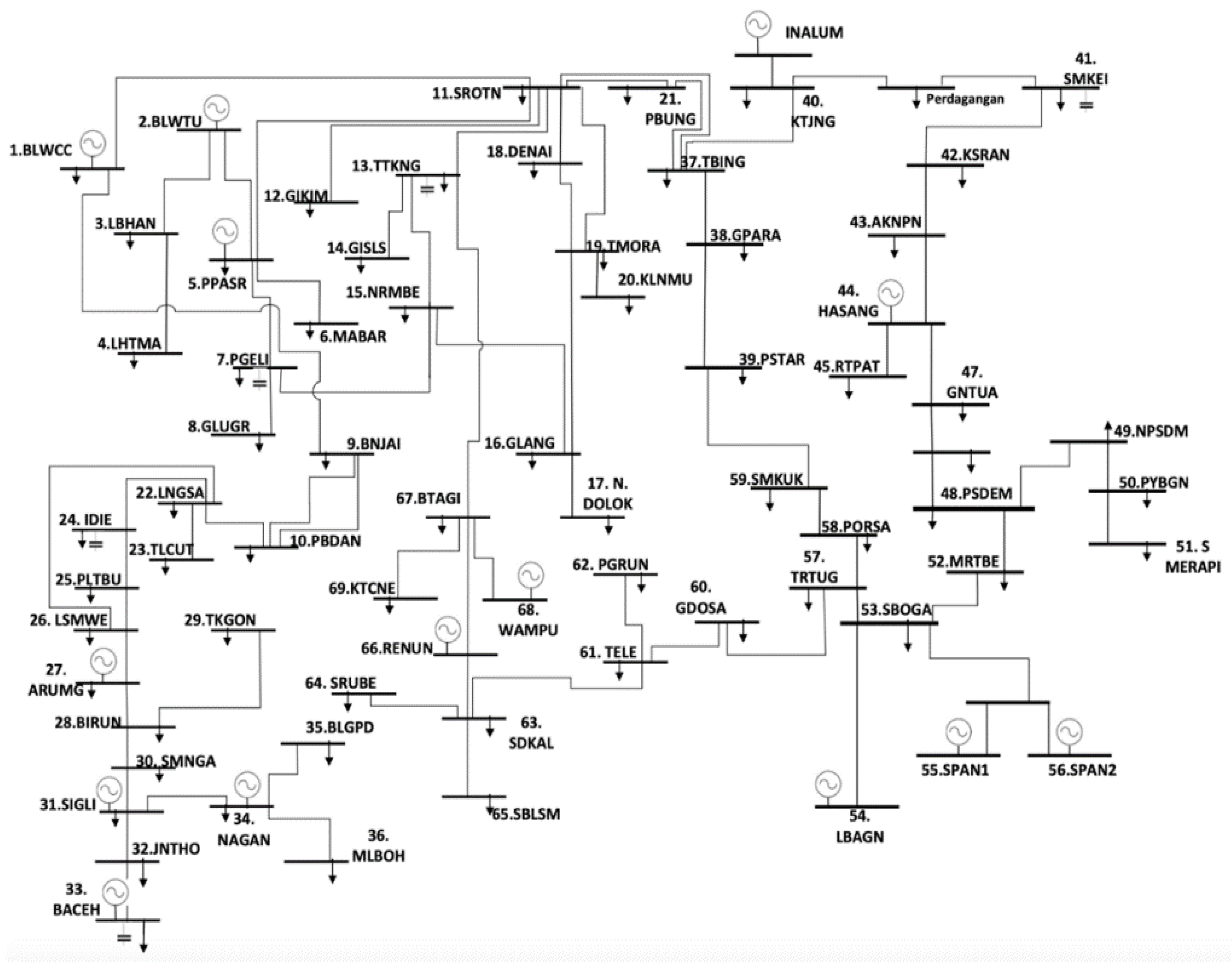
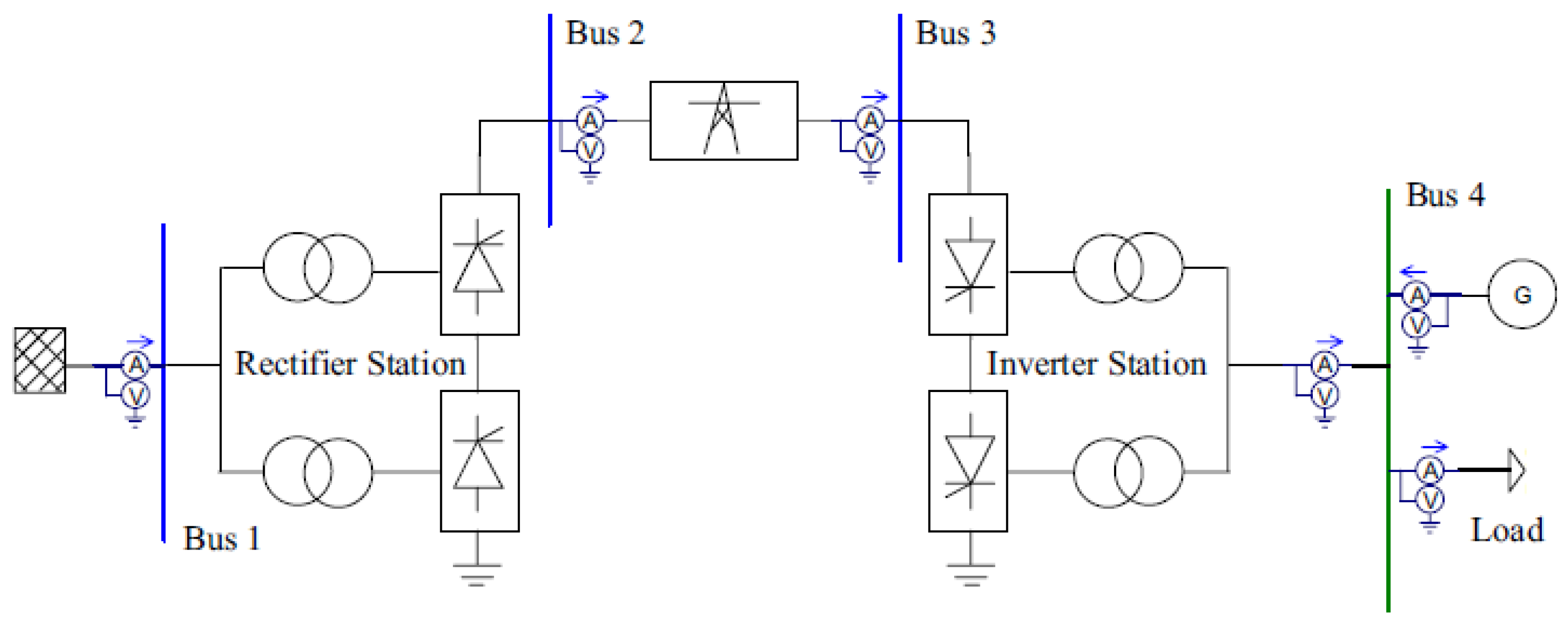
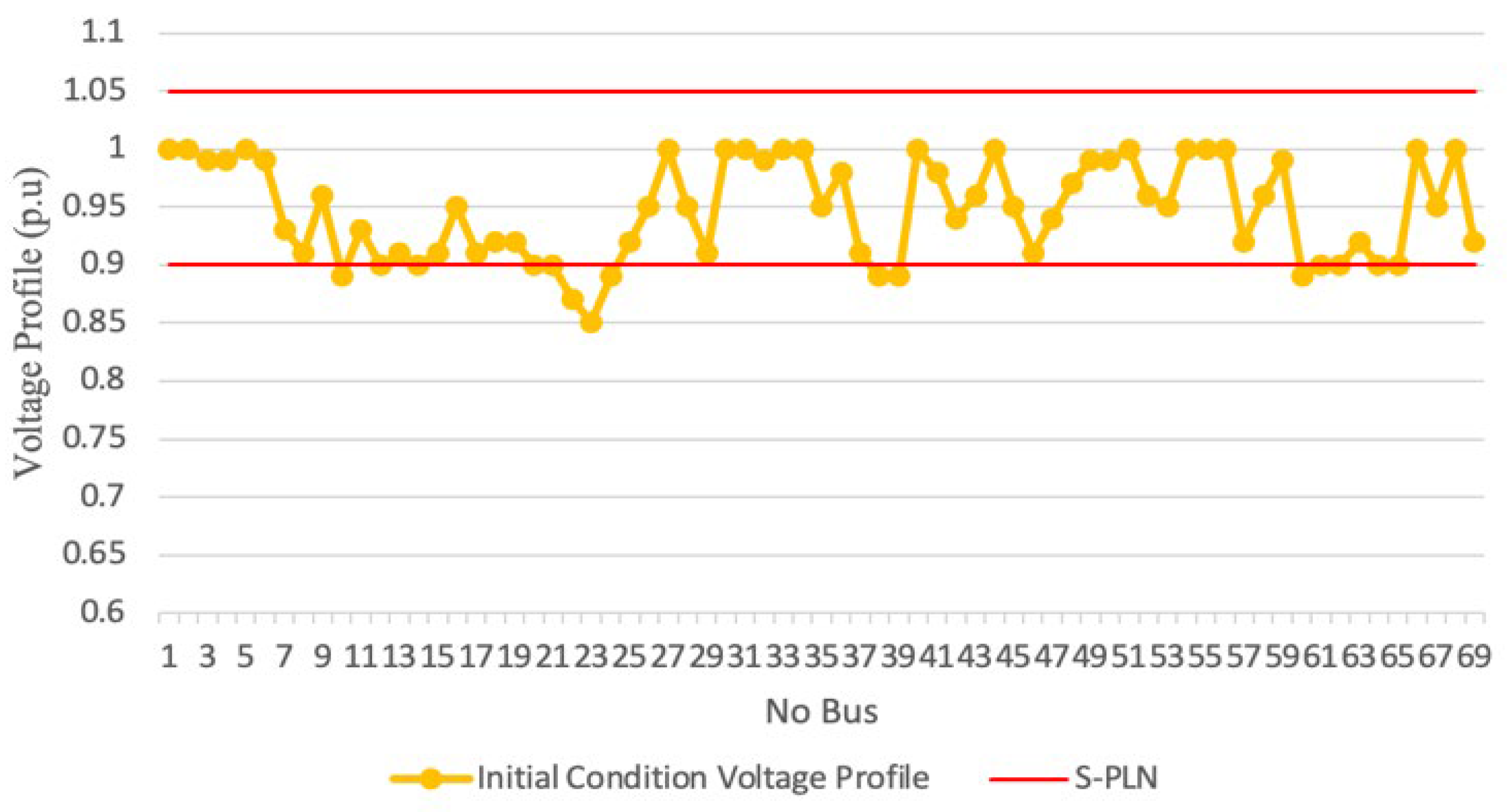
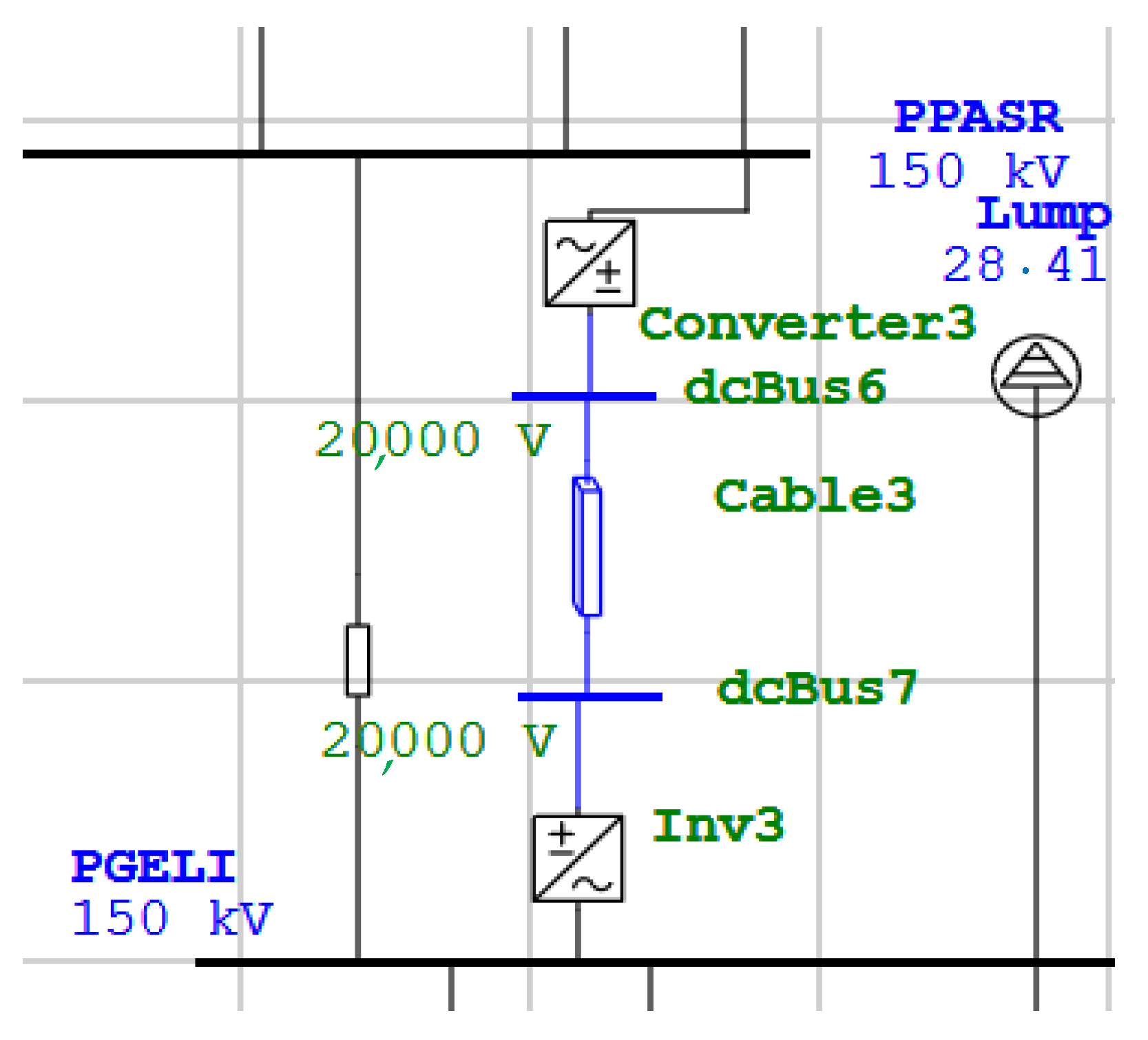
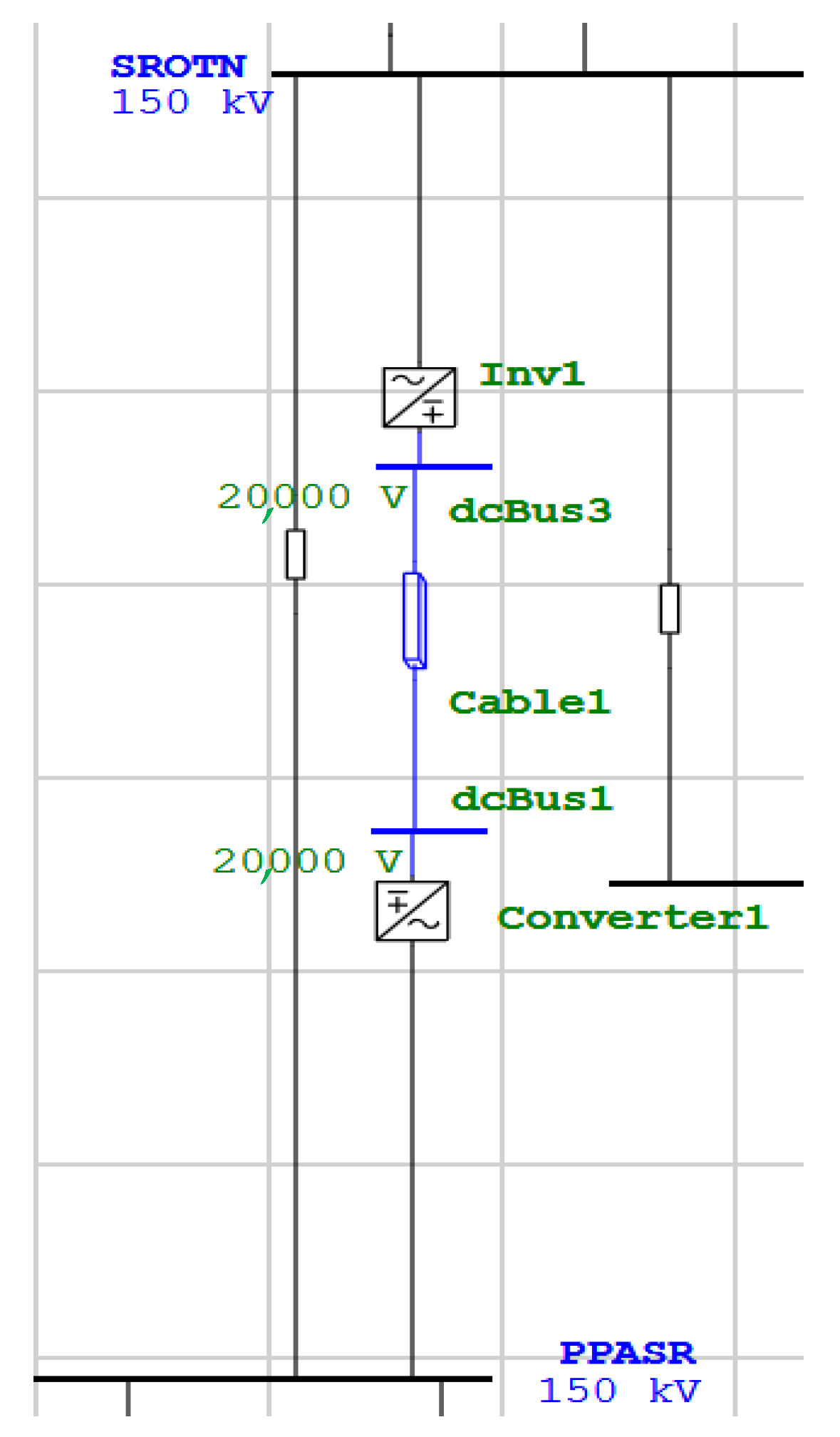

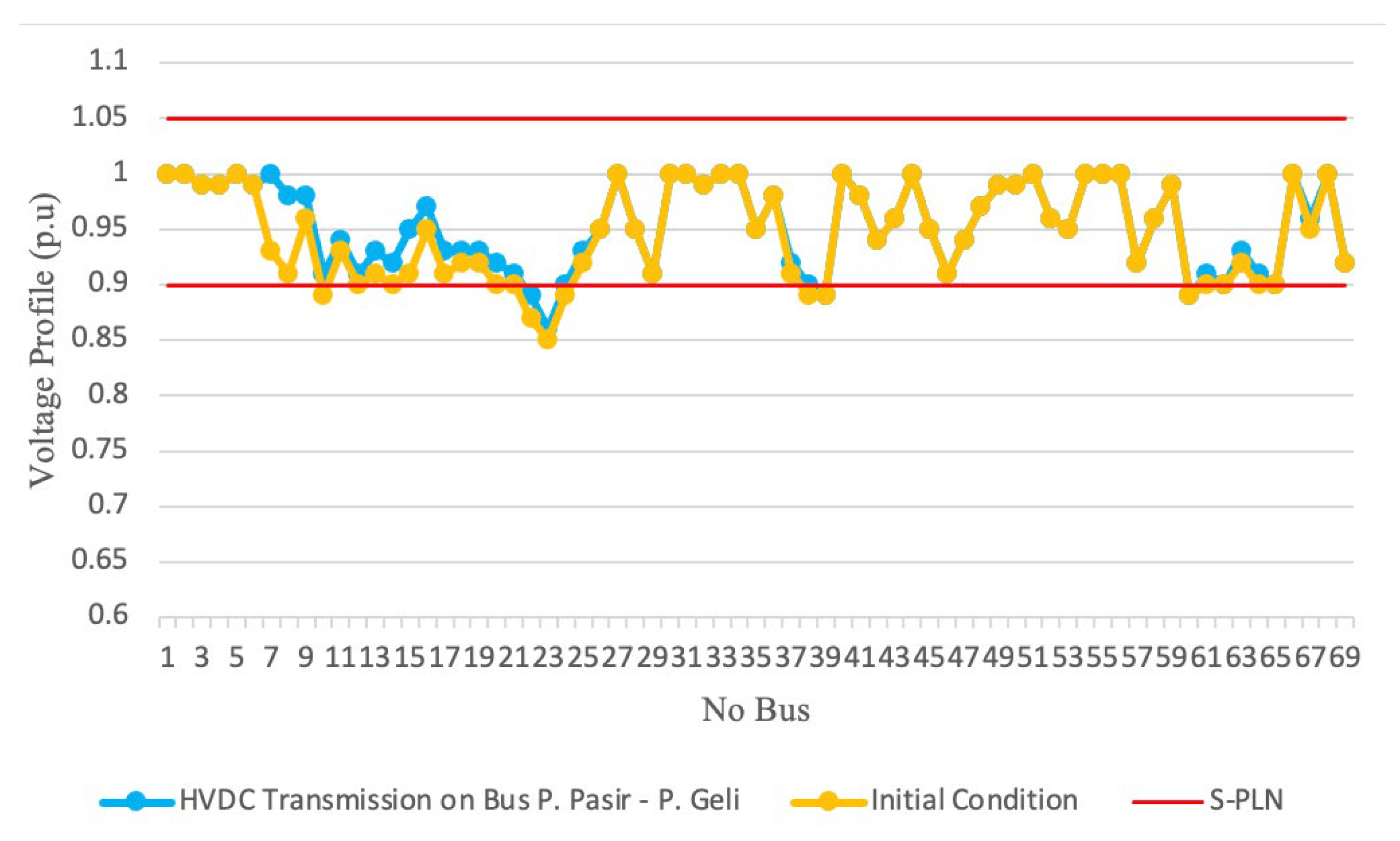

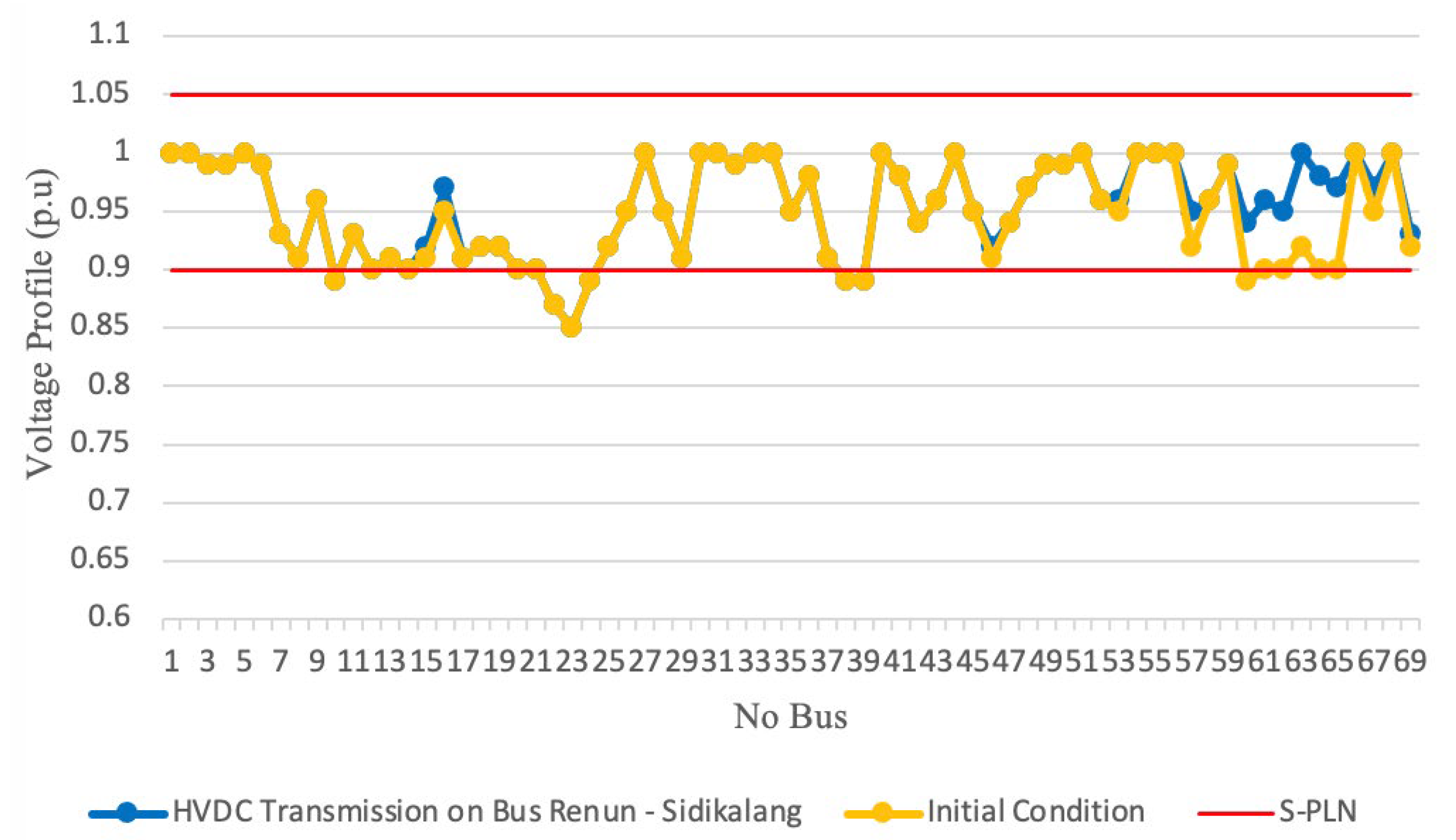


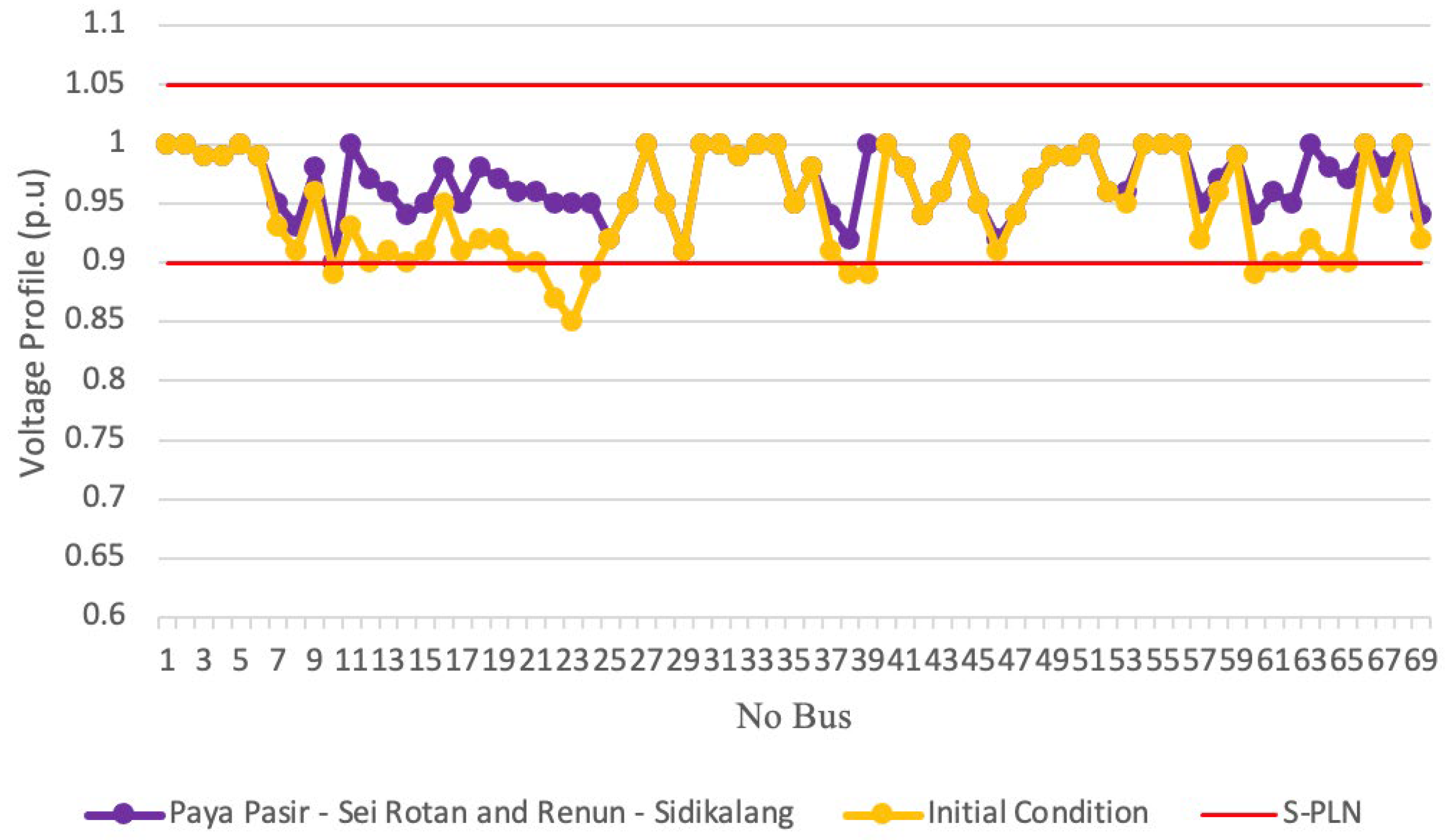
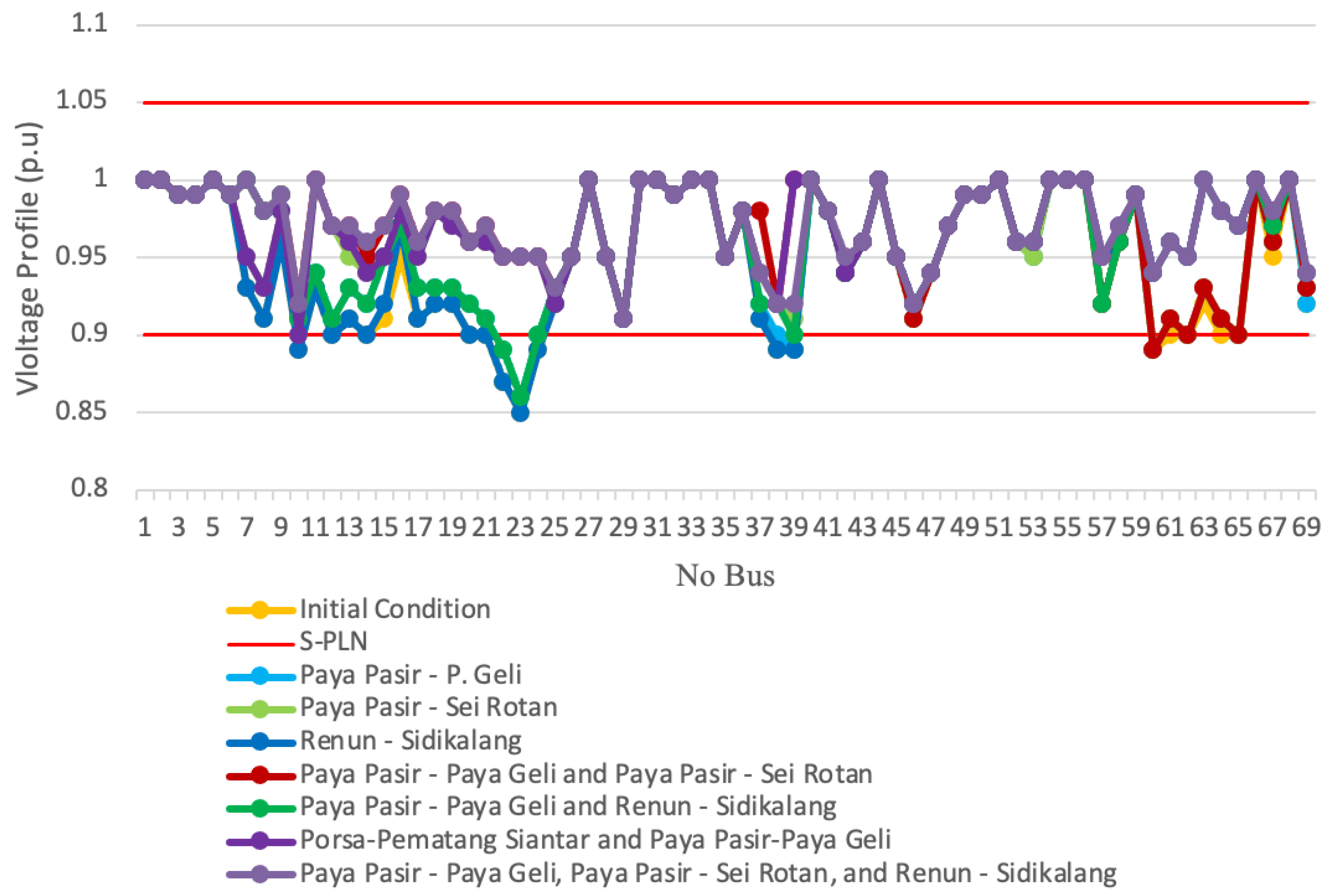
| Bus Type | Bus Name | Number of Buses |
|---|---|---|
| Slack Bus | BLWCC | 1 |
| Bus Generator | BLWTU, PPASR, ARUMG, SIGLI, BACEH, NAGAN, KTJNG, HASANG, LBAGN, SPAN1, SPAN2, RENUN, WAMPU, TPSIL dan TPNIL. | 15 |
| Bus Beban | LBHAN, LHTMA, MABAR, PGELI, GLUGR, BNJAI, PBDN, SROTN, GIKIM, TTKNG, GISLS, NRMBE, GLANG, N.DOLOK, DENAI, TMORA, KLNMU, PBUNG, LNGSA, TLCUT, IDIE, PLTBU, LSMWE, BIRUN, TKGON, SMNGA, JNTHO, BLGPD, MLBOH, TBING, GPARA, PSTAR, SMKEI, KSRAN, AKNPN, RTPAT, KTPNG, GNTUA, PSDEM, NPSDM, PYBGN, SORIK MERAPI, MRTBE, SBOGA, TRTUG, PORSA, SMKUK, GDOSA, TELE, PGRUN, SDKAL, SRUBE, SBLSM, BTAGI, SRULA dan KTCNE. | 56 |
| Amount | 72 | |
| Transmission | Power Loss (MW) | Efficiency (%) |
|---|---|---|
| Initial Conditions | 68.41 | - |
| Paya Pasir (Bus 5)–Paya Geli (Bus 7) | 57.31 | 16.22 |
| Paya Pasir (Bus 5)–Sei Rotan (Bus 11) | 51.79 | 24.29 |
| Renun (Bus 66)–Sidikalang (Bus 63) | 60.8 | 11.12 |
| Paya Pasir (Bus 5)–Paya Geli (Bus 7) and Paya Pasir (Bus 5)–Sei Rotan (Bus 11) | 45.7 | 33.19 |
| Paya Pasir (Bus 5)–Paya Geli (Bus 7) and Renun (Bus 66)–Sidikalang (Bus 63) | 49.95 | 26.98 |
| Paya Pasir (Bus 5)–Sei Rotan (Bus 11) and Renun (Bus 66)–Sidikalang (Bus 63) | 44.69 | 34.67 |
| Paya Pasir (Bus 5)–Paya Geli (Bus 7), Paya Pasir (Bus 5)–Sei Rotan (Bus 11), and Renun (Bus 66)–Sidikalang (Bus 63) | 38.71 | 43.41 |
Publisher’s Note: MDPI stays neutral with regard to jurisdictional claims in published maps and institutional affiliations. |
© 2022 by the authors. Licensee MDPI, Basel, Switzerland. This article is an open access article distributed under the terms and conditions of the Creative Commons Attribution (CC BY) license (https://creativecommons.org/licenses/by/4.0/).
Share and Cite
Siregar, Y.; Pardede, C. Study of Hybrid Transmission HVAC/HVDC by Particle Swarm Optimization (PSO). Energies 2022, 15, 7638. https://doi.org/10.3390/en15207638
Siregar Y, Pardede C. Study of Hybrid Transmission HVAC/HVDC by Particle Swarm Optimization (PSO). Energies. 2022; 15(20):7638. https://doi.org/10.3390/en15207638
Chicago/Turabian StyleSiregar, Yulianta, and Credo Pardede. 2022. "Study of Hybrid Transmission HVAC/HVDC by Particle Swarm Optimization (PSO)" Energies 15, no. 20: 7638. https://doi.org/10.3390/en15207638







